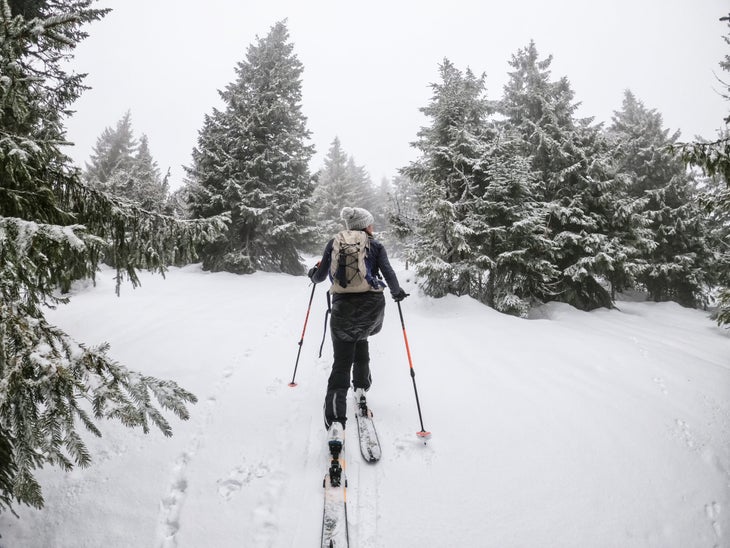Products You May Like
It’s hard to stay hydrated while backcountry skiing. Cold temps always fool me into thinking I’m not thirsty while I’m out on the skin track, and digging a cold water bottle out of my bag is the last thing I want to do on a windy summit. When fatigue starts to set in, I usually blame the long approach or the fact that my partners have been pushing the pace all day. But the truth is, it’s often dehydration catching up to me.
Anytime you sweat, you lose water and electrolytes. So for an activity like ski touring, where you’re often walking uphill for hours at a time, keeping enough fluids in our system is (literally) an uphill battle. We might not feel thirsty, but our body is operating at a deficit.
Get Out There: 8 Classic Backcountry Routes for Beginners to Experts
“Even a one percent drop in hydration status can really impact performance,” says Eden Morris, Registered Dietitian in Jackson, Wyo., and owner of Teton Performance Nutrition. Morris explains that when we get dehydrated our blood volume decreases, our core temperature goes up, brain function goes down, and our muscle contraction is altered, making our body work harder than it has to.
While there are many electrolytes that our bodies need, Morris says sodium is the most important electrolyte to focus on because we lose it so easily when we sweat, alongside potassium, calcium, and magnesium. Sodium and calcium work together to help with muscle contraction, which we need to do quite a bit of in order to get ourselves up the hill and then back down.

“It varies by person, but we lose two to three liters while we’re out in the backcountry just through respiration,” says Morris. That’s why it’s so easy for dehydration to sneak up on us even when we’re not drenched in sweat. Losing fluids and electrolytes through respiration is also why we wake up dehydrated in the morning, which makes it easy to start the day without properly replenishing lost fluids. Morris says she tries to drink 16 to 32 ounces of water before she hits the trailhead to get ahead of dehydration and set herself up for success.
Drink mixes are always top of mind for summer activities—I never think twice about filling bottles with Nuun or Skratch mix before a bike ride or long run—but it doesn’t usually cross my mind while skiing. Morris says that when it comes to hydration, if you’re going to be out for less than an hour, water is fine, but for activities lasting longer than an hour (pretty much any ski tour), you should consider a supplement for electrolyte replacement.
Drink mixes are a convenient way to make sure we’re getting the electrolytes that we need, but Morris adds that it doesn’t have to be a mix to do the job. Since cold water never sounds good on the skin track, her go-to warm winter drink is what she calls Ski Tea (chai tea, oat or soy milk, 1/2 teaspoon of salt, and honey), which has a boost of sodium and carbs from the honey. If you’d rather not sip electrolytes, adding salty and savory snacks to the mix is another way to replenish lost sodium. Pretzels, crackers, and salty cured meats are sneaky ways to boost sodium, which alongside plenty of water, will help keep your body going when the fatigue sets in.
Also Read: The 7 Best Backcountry Skis of 2022
“If you get thirsty, you’re already dehydrated,” says Morris, who’s a big proponent of staying ahead of your body’s needs. “But I usually tell people not to focus too much on the numbers and how much you should be drinking, just make sure you’re drinking and eating something at every break.”
This winter, I’ve experimented a bit more with adding electrolytes to my bottles and mixing in some savory snacks with the mountains of peanut butter cups and sweet granola bars that I usually chow on. I like to carry two liters of water for a long tour, and while I enjoy sipping on some flavored mixes, I hit my limit pretty quickly. Along with 1 to 1.5 liters of plain water, I started adding Nuun Endurance mix to a 16-ounce Nalgene bottle so I could have some electrolytes without committing to entirely flavored fluids. They also come in single-serving packets, which I started keeping in my snack bag in case I need more.
All in all, when I stay up on my electrolytes, I can finish a day in the backcountry feeling much stronger and more energetic than days where I just bring water. Since there’s already so much preparation and gear needed for backcountry skiing, it’s easy to overlook what seems like a small detail, but I’ve found it to give me the edge I need to keep going on a long day, and recover better for tomorrow’s turns.
